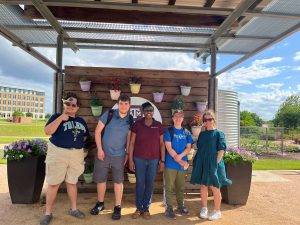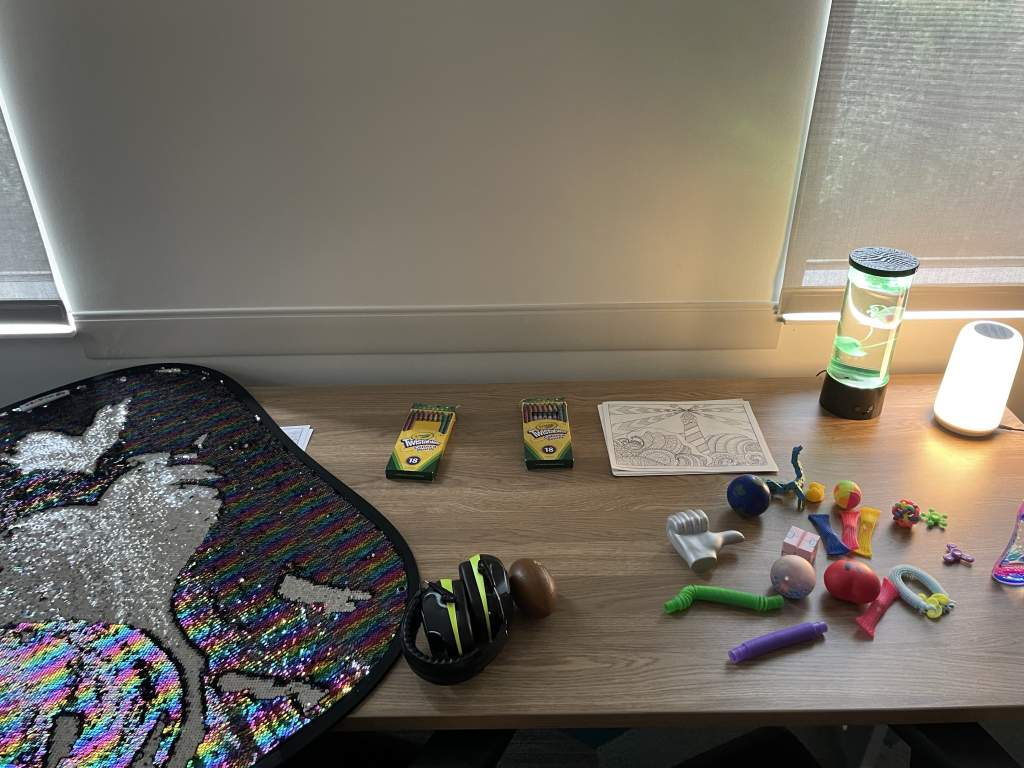
About Spectrum in Aggieland
Spectrum in Aggieland is a program administered by Disability Resources to support students on the Autism Spectrum. Previously, Spectrum in Aggieland was a Living Learning Community (LLC) on campus but during the Fall 2023 semester it transitioned into a program to support students, faculty, and staff through 3 main purposes:
- Engaging with autistic students through weekly meetings
- Educating faculty, staff, and the campus community about autism
- Provide a safe space for students by offering a pop-up sensory room
To learn more, please fill out the interest form to be placed on our mailing list. You are also welcome to contact Disability Resources and ask to speak to an Access Coordinator who facilitates the group. Please contact the office at 979.845.1637 or [email protected].
- Primary Coordinator: Joshua Page, Access Coordinator – [email protected]
For Students

Participation in the Spectrum in Aggieland program is free of charge and all students who identify as autistic are welcome to join. Students do not need to be registered with Disability Resources to be able to participate. The program has weekly meetings which focuses on providing resources and discussions targeted to students’ needs and interests. We aim to create a safe space through social and community building.
Previous semesters have included topics such as transition to college life, preparing for job searching, and technology. Speakers have presented from on campus resources such as the Career Center, the Academic Success Center, the University Writing Center, and Disability Resources.
For Faculty and Staff
Spectrum in Aggieland works to educate faculty and staff through informational sessions, presentations, and webinars on autism and related topics. Education can also be provided on accessibility and how to promote inclusivity for autistic individuals.
What is a pop-up sensory room?
The pop-up sensory room is a mobile sensory room that can be used for a variety of events and/or on campus activities. A sensory room helps reduce overstimulation, creates a safe space to self-organize and regain a sense of calm. This space can be used by anyone who may be feeling overwhelmed and/or overstimulated and needs a place to take a break. This is not just for students with disabilities. These rooms can include the following items: low lighting/lamps, comfortable seating, white noise machines, fidget items, and art supplies.
What are the benefits of a sensory room?
Students who are experiencing sensory overload may avoid socializing, not be able to focus or concentrate, and cause fatigue and stress. This can impact students academically and socially. When a sensory space is provided for students, this can help them emotionally regulate and destress, so they are able to rejoin the event or activity.
When might a sensory room be used?
The pop-up sensory room could be used at events that will have large amounts of people and overstimulation such as New Student Conferences, Career Fairs, Howdy Week Events, etc.
How do I use the pop-up sensory room?
Fill out the request form under the Interest Form tab. After you submit a request, you will be contacted with more information. The day of or day before your event, someone from your event will come and pick up the supplies. You will be provided a wagon with a variety of sensory items to use in the room as well as a checklist and instructions on how to set up the room. It will take approximately 30 minutes to set up the room and about 15 minutes to tear down. After the event is over, you will return all the items. You should ideally use a room the size of a small conference room to have a pop-up sensory room so that there is enough space for a few individuals to be in the room at the same time without it feeling crowded.
Pickup/Drop-off: Student Services Building 122
Want more information?
To learn more, please fill out the interest form and you will be contacted by our Coordinator to answer any questions or give you more information. You are also welcome to contact any of the Access Coordinators who facilitate the group directly, or call the Disability Resources office at 979-845-1637
- Pop-up Sensory Room Coordinator: Kristin Eiland, Access Coordinator – [email protected]
Request More Information about Spectrum
Have questions about the Spectrum in Aggieland program or are interested in attending meetings? Want more information about sensory rooms or would like to use the pop-up sensory room at your event? Fill out the forms below.
Webinars and Presentations
Employment and Autism for College Students and Graduates
Presented by Amy Rutherford and Kendra Evans
This session features Amy Rutherford of College Autism Spectrum and Kendra Evans of the Rochester Institute of Technology in a 90-minute virtual discussion on supporting employment opportunities for autistic college students and graduates. View the Employment and Autism for College Students and Graduates webinar
Supporting Neurodivergent Students (September 2023)
Presented by John Caldora (University of Kentucky)
Campuses across the country (including Texas A&M) are seeing an increase in students with autism. Autistic students come to campus academically prepared but are sometimes challenged by the lack of structure, large campus size, and ambiguity of social cues in our environment. John will provide insights on how to best support autistic students in the classroom and campus from his experience as both an autistic adult and a disability resource professional. View the Supporting Neurodivergent Students webinar
“Oh, that’s it?” Simple Strategies for Supporting Aggies on the Spectrum (and ALL Aggies!)
Presented by Dr. Erinn Whiteside, Texas A&M University
In this Spectrum in Aggieland presentation, Texas A&M faculty member Dr. Erinn Whiteside will share simple strategies used to support Aggies on the autism spectrum. These strategies, which are also helpful for ALL individuals, are shared as small changes you can make before and during instruction to help support all learners in your classroom. Statistically, you are likely to have an autistic student on your roster. View the “Oh, that’s it?” Simple Strategies for Supporting Aggies on the Spectrum (and ALL Aggies!) webinar
Podcasts
- Autistic & Neurodivergent College Students (Student Affairs Now)
Websites
- Stairway to STEM: Resources for autistic students / students on the autism spectrum transitioning from high school to college, particularly in Science, Technology, Engineering, and Math (STEM) fields.
- Autistic Self Advocacy Network
- Autism Acceptance
- College Autism Network: Advocacy, Research, Training
Books
- Supporting Neurodiverse College Student Success By Elizabeth Coghill, Jeffery Coghill
- Loud Hands: Autistic People, Speaking by Julia Bascom



